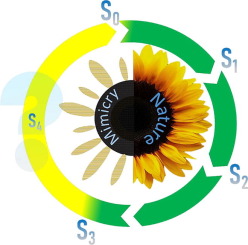Coordination Chemistry Reviews ( IF 20.3 ) Pub Date : 2019-09-26 , DOI: 10.1016/j.ccr.2019.213068 Mojtaba Shamsipur , Afshin Pashabadi

|
Complete biomimicking, a quest that has motivated many of scientific communities to attempt to unravel strange aspects of biological water oxidation reaction (WOR). Achieving this utopia allows designing nature-resemble artificial leaves for the final production of oxygen with yields comparable to nature, and ultimately facile production of eco-friendly fuel i.e. molecular hydrogen. The former case, WOR, has been traditionally regarded as the bottleneck which mostly suffers from high energy loss due to the difficulty in decreasing activation energy. Toward this end, tremendous boosts have been assigned to explore the mechanism of a water oxidation reaction in nature and discover the tricks of the trade. The formation of molecular oxygen is catalyzed via an active core in the oxygen-evolving catalyst (OEC) located in photosystem II, where the oxido-manganese bonds arranged in an asymmetrical cluster structure, is responsible for the accumulation of the redox equivalents that are capable for the concurrent abstraction of four electrons/protons from two water molecules. Understanding the precise mechanism of WOR in nature being the subject of frequent of research items, in this way, a reliable approach is constructing artificial architectures that either one mimic different aspects of PSII including the OEC core, the electron transfer chain, and the proton-coupled electron transfer (PCET) aiming to investigate the structural-dependent electronic properties and the redox chemistry of the biomimetic systems, which can discover new details in PSII supercomplex. Here, we discuss a critical overview of the latest advancements in biomimicry that being able to delineate new insights on uncover secrets of WOR in nature.
中文翻译:

迄今为止,仿生学带来了什么神秘的自然氧释放?
完全生物模仿,这一探索激发了许多科学界试图揭示生物水氧化反应(WOR)的奇怪方面。实现这种乌托邦,可以设计出类似于自然的人工叶子,以最终产生氧气,其产量可与自然相媲美,并最终容易地生产出生态友好型燃料,即分子氢。传统上将前一种情况称为WOR,这是瓶颈,由于难以降低活化能,因此大部分能量损失很大。为此,人们大力推动探索自然界中水氧化反应的机理并发现交易技巧。分子氧的形成是通过位于光系统II中的放氧催化剂(OEC)中的活性核催化的,其中氧化锰键以不对称簇结构排列,负责氧化还原当量的累积,这些氧化还原当量能够同时从两个水分子中提取四个电子/质子。了解自然界中WOR的精确机制是经常研究的课题,因此,一种可靠的方法是构建一种人工结构,该结构可以模仿PSII的不同方面,包括OEC核,电子传输链和质子-耦合电子转移(PCET)旨在研究仿生系统的结构依赖性电子性质和氧化还原化学,可以发现PSII超复合物中的新细节。这里,











































 京公网安备 11010802027423号
京公网安备 11010802027423号